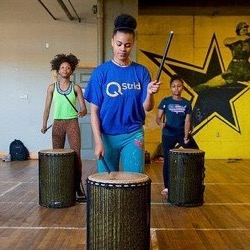Cultural Scripts Round 2: Heritage Works
Navigation Menu
- Advocacy Resources
- Artist’s Legacy Toolkit
- Audience Engagement Strategies
- Building Audiences for the Arts: Research and Resources
- Coronavirus Resources
- Dance/USA Fellowships
- Dance/USA Task Force on Dancer Health
- Equitable Contracting Resources
- Funding Resources
- Harassment in the Workplace Resources
- Jobs, Auditions, & Internships
- Key Advocacy Issues
- Music and Choreography Resources
- Mentorship Program: Dance/USA Institute for Leadership Training
- Request a Peer Consultation Letter
- Scheduling Congressional Visits
-
 Organization Name: Heritage Works
Organization Name: Heritage Works
Department Submitting Recipe: N/A
City: Detroit
Program Name: Cultural Scripts
Time of Program: Varies and depends on availability of audiences. This includes during school, after school, evenings, at work and during major events.
Program Length: 60-120 minutes
Program When Elaborate: Program is offered months before the performance, during the creation of art, and after the performance.
Goal: The overall project goals of Cultural Scripts Round II are: 1) engage residents and renown artists in illuminating metro Detroit communities, highlighting the diversity of heritage, culture, and religion within; 2) foster personal stories that promote understanding, empathy, and recognition via community dialogues; 3) Create and share new narratives via dance traditions and other authentic cultural languages (e.g., storytelling, music); and 4) create and promote new Detroit-focused, culturally- relevant work.
Time of Year Offered: Fall (e.g., november), Summer
Program Description:
Cultural Scripts, a Heritage Works’ project of dance and dialogue, engages the people of metro Detroit in the exploration of cultural traditions, normalcy, identity, and empowerment via cultural traditions. Cultural Scripts brings renowned choreographers to Detroit, all grounded in a specific cultural background while also pushing creative and cultural boundaries. Each of these artists progresses through three sets of activities: 1) Discovery Dialogues (i.e., dance or story-based conversations); 2) New Work Creation; & 3) Performances & Talk Backs. These activities aimed to transform each person, and the region, by intentionally engaging participants at each phase.
Number of Participants: Across five dialogues, art work creations and workshops, and final performances, we estimate 2,000 intensively.
Target Audience: Cultural Scripts audiences included African, African American and Muslim youth, young adults, artists, families, movement artists and the general public.
Is the program for kids? Majority of activities are intended for out of school. We do hold two dialogues in school as transportation is a barrier in Detroit. The primary purpose is self-expression and youth development via workforce development (e.g., artistic and administrative).
Private/Public Public
Nature of Audience Engagement: Audience participants engage in each of the following by: Dialogues: Contributing 3-4 minute personal stories in response to story circle prompts, contributing gestures, written responses if preferred, and in the end reflecting on either their own or another’s story. Performance/Talk Backs: Watching, listening, calling out to dancers, responding in writing to evaluation survey first and then verbally to facilitator; then participating in talk back with visiting artists and youth performers.
Location: Our program takes place in schools, community centers, art galleries, and museums. The goal is to hold them in places where target audiences frequent.
How Many Staff: We had 2 – 5 and could have used 3 more. Their roles were: Outreach Coordinator (.8 FTE), Ensemble/Studio Manager (1 FTE), Executive Director (1.5 FTE), and Ensemble Members (Seasonal – .75 FTE/10 ppl at .75 FTE). They manage activities and relationship with outreach partners, visiting artists and ensemble artists, and funders and other institutional partners and contractors.
Program Cost: $120,000
Marketing for Program: Program is marketed via printed and electronic flier, e-blasts, and the promotions of affinity/partner groups. Heritage Works also contracted with a PR firm to have advanced articles/mentioned included in local circulars.
Cost for Program Participants: Free
Attendance To Date: 2,000 estimated this year
Past Iterations: We have implemented Cultural Scripts two times before this implementation. Within each round of Cultural Scripts, we host 5 dialogues so we have hosted 10 dialogues before this year.
What works? Embedding Artists in Community: We often get push back from artists that usually work in communities in shorter stints, etc. In the end, the artist appreciates the time to learn from and with and develop or strengthen relationships with Detroiters, our youth members definitely appreciate and demonstrate growth through this exposure, and our participant audiences express appreciation of the work and process by which their feedback was interpreted.
What doesn’t work? The timing or timeline of our project does not work. We find we contract with an artist when we seek funding but they often have other commitments or have moved on by the time we reach implementation. As a result, we often implement with another group of artists. This has both positively and negatively impacted the intentions of the project. Bringing visiting artists in together. We often ask them not to collaborate on their work because we want their works to represent different viewpoints, but many artists are often collaborative in nature and it is reflected in the final works.
Performances Where Offered: No, we began by offering it during our summer programs. We have not considered expanding it to other programs. We do try to engage all of our audience segments — youth, artists/creatives, and families.
Past Research on Program: N/A
Continuing Program? Yes. Factors included wanting to explore the Black Body from two aspects – individual and corporate.
